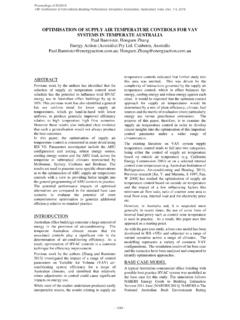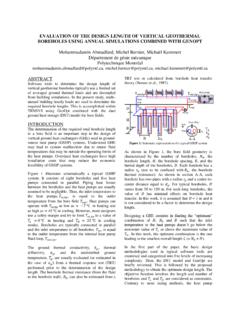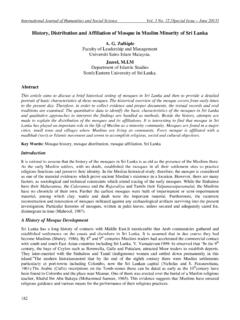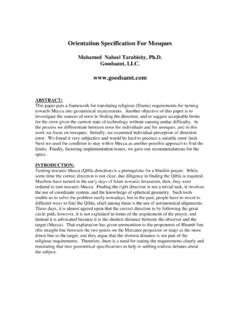Transcription of COMPARISON OF THE ACOUSTICAL PERFORMANCE OF …
1 COMPARISON OF THE ACOUSTICAL PERFORMANCE OF mosque geometry USING COMPUTER MODEL STUDIES Adel A. Abdou King Fahd University of Petroleum and Minerals Architectural Engineering Department Dhahran, Saudi Arabia ABSTRACT Speech intelligibility is a major concern in mosque ACOUSTICAL design. Diverse mosque geometric configurations exist varying from the classical rectangle to the octagon-shaped plan. This study investigates the ACOUSTICAL PERFORMANCE of commonly built forms of mosques utilizing room-acoustics computer models. Simulation of sound fields of five simple forms is conducted for different religious activities and level of occupancy. The purpose is to identify the impact of the mosque geometry on its acoustics, particularly on the spatial distribution patterns of speech intelligibility in the absence of sound reinforcement systems. Speech intelligibility contours were quantified and compared to characterize acoustic merits, dissimilarities and overall PERFORMANCE .
2 Insignificant differences were found. Of all the shapes, (standard designs) the octagonal mosque possesses the fewest merits. The investigation is expected to help architects to understand better the effect of early architectural design decisions with respect to form on mosque acoustics. INTRODUCTION Acoustic modeling and simulation are beneficial and effective computer-based tools. Room-acoustics programs have typically been used for the prediction and assessment of room acoustic indicators in the early design stage of various spaces. For example, the prediction of echograms and impulse responses within enclosures utilizing Epidaure software was described (Maercke and Martin, 1993). The Odeon acoustics simulation package (ODEON, www), a combined beam tracing and radiant computer model of room acoustics, was developed (Naylor, 1993). Using such computer modeling and simulation, problems such as echoes can be identified and the overall acoustic PERFORMANCE of spaces intended for particular functions can be assessed before actual construction begins (Claus, 2001).
3 The impact of architectural design decisions can be readily visualized and even listened to, developing an appreciation of the results via a cause and effect type of analysis. In addition, computations of introducing sound reinforcement systems using multiple electro-acoustic sources can be investigated at the early design stages. As well as the ODEON program, CATT, CARA, RAYNOISE, AURORA, RAMSETE, and NEMPEE (web sites) are a few examples of similar acoustics simulation software packages with a variety of features and merits. Nowadays, as a result of continuous research and development, room- ACOUSTICAL computer models have significantly improved becoming reliable and efficient design tools for ACOUSTICAL investigations. Rindel (2000) well described the various methods of simulating sound in rooms. Earlier, Abdou (1999) employed such tools for predicting and assessing the ACOUSTICAL PERFORMANCE of mosques.
4 Recently, computer simulations of the acoustics of mosques and Byzantine churches were also conducted (Wetiz et al., 2001). Moreover, acoustic computer simulations were carried out for Hagia Sophia, which is characterized as one of the largest buildings of worship in the world. The room acoustic differences in the three historical periods when the building was used as a church, a mosque and, currently, as a museum were investigated by creating three different computer models. Each included the particular function and relevant furnishings. Wetiz et al. (2002) applied the acoustic computer simulations on some of the old churches and mosques in Istanbul for the purpose of comparing between in-situ recordings and auralization obtained from simulations utilizing the ODEON program. geometry OF MOSQUES Mosques possess basic common design features as spaces for worship (King, 1986, and Sergeld, 1996).
5 The mosque is typically a simple rectangular, walled enclosure with a roofed prayer-hall. The long side of the rectangle is always oriented towards the holy mosque in Makka city in Saudi Arabia. This wall called the "Qibla" wall is always emphasized by a central niche (called Mihrab ). To its right an elevated floor (called "Minbar") is used by the preacher ( , the "Imam") to deliver the religious "Friday" speech ( , "Khutba") preceding the prayers. Figure 1(a) illustrates the basic elements of the mosque space design. Eighth International IBPSA Conference Eindhoven, Netherlands August 11-14, 2003 - 39 -- 39 - Interior materials and finishes of mosques vary from one country to another. However, mosque walls are commonly finished with painted plaster. Wall wainscots are sometimes covered with marble tiles or wooden boards or panels tongued and grooved to compose a vertical pattern.
6 The floor area is always carpeted. Plastered and painted concrete ceilings with simple to elaborate decorations and /or inscriptions are commonly used. Depending on the climatic conditions, the mosque may be equipped with an air-conditioning system, in concert with some ceiling fans. Electro-acoustic sound reinforcement systems have also been installed in mosques of all sizes to improve the hearing conditions in the space, particularly when air-conditioning systems are introduced due to the subsequent increase of indoor ambient noise in the mosque . ACOUSTICS OF MOSQUES The acoustics of a room are commonly judged by their reverberance evaluated from the sound level decay curves. The first, conventional Reverberation Time (RT), is defined as the time it takes for sound to decay by 60 dB after the sound source has stopped. It is usually determined by extrapolating the slope of a straight line fitted to the first part of reverberant decay curves as a function of frequency between -5 and -25 (RT20), or -35dB (RT30).
7 The second indicator is the Early Decay Time (EDT), which is found to be a subjectively more relevant indicator than RT and is defined as the sound decay slope of a straight line fitted to the decay observed during the first -10 dB. EDT values are more influenced by the Figure1 (a) The main design elements and features of the mosque prayer hall, (b) The investigated mosque geometry overlaid, and (c) 3D illustrations of the modeled mosque forms. "" DirectionQiblaR1R2R3R13R14R4R5R6R7R8R9R1 0R11R12""MinbarWall niche""Mihrab"" wallQibla(b) (a) Notes : 1. Floor area is kept constant 2. Volume is kept constant Wall Wainscot Wall niche Mihrab Rectangle Trapezoid Square Hexagon Octagon (c) - 40 -- 40 -details of early reflections. Both measures indicate reverberance as a function of frequency, which in turn appears to be responsible for the sensation of being in a room as well as providing a sensation of distance from the sound source.
8 Optimal RT values depend on the desired function of the hall, the hall volume and interior surface finishes. For optimum listening conditions for speech intelligibility RT values must be in the range of about to second at mid-frequencies ( , average of RT at 500 and 1000 Hz one-octave bands RTm). Preferred ranges of RT values at mid-frequencies for a variety of activities are well established. For example an RT value of less than sec is desired for an intimate drama theatre, lecturing or for speech activities while sec is acceptable if the space is to be used as a multi-purpose hall (Templeton et al., 1997). The effect of the enclosure acoustics on speech intelligibility (SI) is found to be better related to the beneficial sound energy of the direct sound and reflections arriving within the 50 ms after the direct sound. Late arriving reflections, indicated by a long reverberation time, reduce intelligibility.
9 The subjective balance between sound clarity, definition and reverberance can be judged by the arriving early-to-late sound ratio indicators such as Clarity (C50,), defined as the ratio of the early arriving sound energy in the first 50 ms after the direct sound to the late sound energy arriving afterwards. Clarity is increasingly considered more indicative of the impact of the room on SI. For clarity and blend balance expressed by the foregoing indicators, a low value indicates poor definition, referred to subjectively as muddy sound. While a high value indicates that it is possible to discriminate the sound details, the sound may also be subjectively very dry as if it is produced in a room with too much absorption. Unlike the ACOUSTICAL characteristics and requirements of other religions spaces, which require the design for both speech and music, speech intelligibility is the only major concern of mosque acoustics.
10 The intelligibility of speech in a mosque is essential to the performing of prayers and related religious activities. All activities in the mosque are dependent on speech audibility and intelligibility. These two factors are, thus, critical to the evaluation of sound quality in a mosque . Knowledge pertinent to mosque acoustics in this regard, compared to that of other religious enclosures where speech intelligibility is also important, has received very little attention. The intelligibility of speech in rooms is related to both the speech sound level and to the ambient noise expressed by speech signal-to-noise ratio and to the ACOUSTICAL characteristics of the space indicated by reverberation time. The less the room reverberance and the higher the level of the speech sound relative to the ambient noise, the greater the intelligibility of the speech. Many indicators can be used in order to measure, assess and/or predict speech intelligibility (Johan, 1997).



















